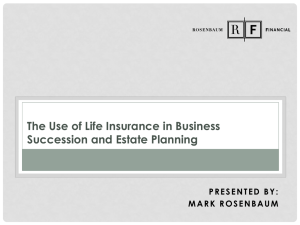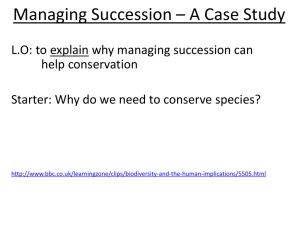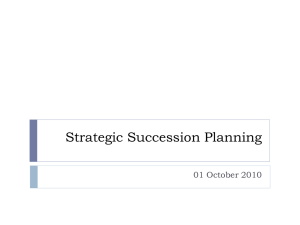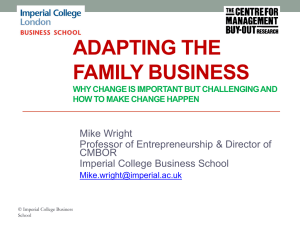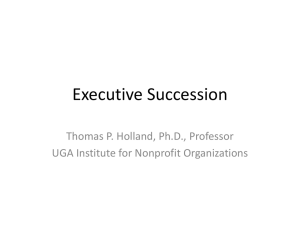secondary succession
advertisement
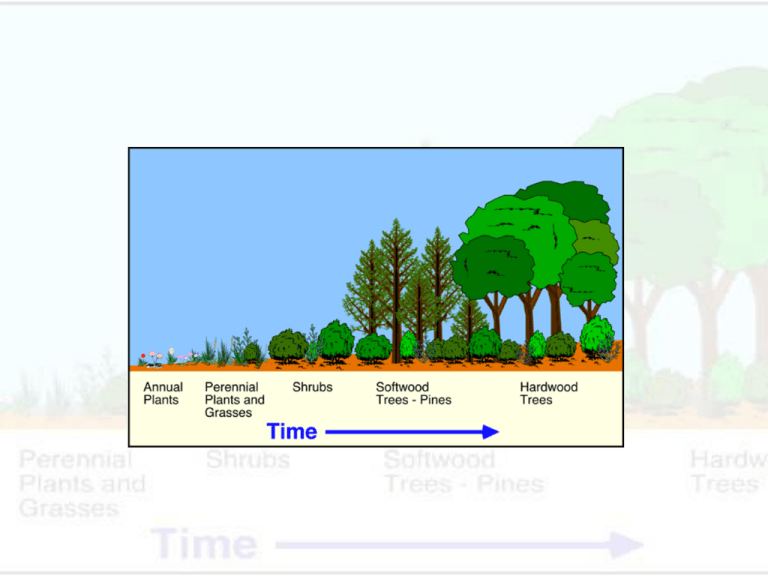
Succession • There is always flux in community composition, but there may be apparent directional change (e.g. an orderly process of community development that is reasonably directional and somewhat predictable). • Thus succession is a temporal change in community composition Succession • Succession can be viewed as the temporal changes in species composition following natural or anthropogenic disturbances • However, it can also be a series of minor changes of structure and operation accumulate over time Succession • Early studies documented dramatic temporal changes in plant species composition Succession Models • These patterns of succession have been documented in old fields from North Carolina to New Jersey and to the mid-west • Although the species composition varies between sites and regions, there is a general pattern: annuals, biennials, perennial herbs, short-lived conifers, to a mature mixed hardwood forest Succession Models • Succession can be viewed as primary succession (sites without vegetation) or secondary succession (sites with established vegetation) • During primary succession, propagules typically arrive from distant locations • Process may be relatively slow as secondary colonizers cannot arrive until bare ground can be transformed into suitable habitat Succession • Bare ground must be broken down and enriched with nitrogen Succession • The successional paradigm works well for such obvious examples as primary succession in the wake of retreating glaciers or volcanic islands Succession Models • Secondary succession alters one vegetative type into another Succession Models • Another way in which ecologists differentiate between succession types is that of autogenic succession (driven by processes operating within a particular location) and allogenic succession (driven by processes outside a particular site) Succession Models • One of the goals in understanding succession is to help predict and accelerate community changes after natural disturbances such as fires or storms Succession Models • Optimal ecological restoration of sites disturbed by human activity clearly depends upon knowledge of the factors that promote rapid or otherwise desirable successional changes Succession Models • There are other types of succession besides primary or secondary succession • Seasonal succession refers to a regular annual phenology of abundance or activity that occurs without the permanent loss or addition of species from the community Succession Models • Examples include the sequence of flowering by woodland plants, seasonal variation in insect reproduction, or seasonal variation in the activity and abundance of aquatic microorganisms Succession Models • Cyclic succession occurs in special circumstances in which a small number of species tends to replace each other over time • A classic example involves heather (Calluna) and the bracken fern (Pteridium). Calluna can invade stands of Pteridium under some situations. However, as the Calluna plants age and senesce, they can be replaced by Pteridium Succession: a brief history • Henry Chandler Cowles (1899) was one of the first individuals to recognize succession as an ecological phenomenon • Using Lake Michigan dunes of different ages, he inferred successional patterns Succession: a brief history • This approach, sometimes called space for time substitution or chronoseries, can be used to infer successional patterns • Can you see the advantage? • Can you see a potential disadvantage? Succession: a brief history • Clements, often viewed as the forefather of successional theory, perceived succession as a deterministic phenomenon, a development within the community proceeding directionally to some ‘climax’ community through a series of distinct seral stages • Different communities were the result of environmental regimes Succession: a brief history • Succession was seen as convergent, with communities of a wide variety of initial starting points converging on a limited number climax states • This can be largely predictable – E.g. if the succession is set-back, it will just pick up on the same trajectory as to where it was heading Succession: a brief history • Conversely, other botanists such as Cooper, Gleason, and Tinsley all viewed communities as a more random assemblage of individuals existing as snapshots in time and space • Individuals abundances rise and fall somewhat independent of one another (although similar conditions may be driving changes) Succession: a brief history • Frank Egler (1952) provided the next important conceptual development in succession promoting the idea that became known as the initial floristic composition hypothesis • Addresses the pattern of secondary succession and holds that succession at a site is determined largely by the species composition of plant propagules already present when the site is disturbed • Subsequent changes due to differing longevity Succession: a brief history • Eugene Odum (1969) viewed succession as an orderly (i.e. predictable) pattern of community development that produced significant changes in a variety of ecosystem attributes • This orderly process was due to modifications of the environment driven by the developing community Succession: a brief history • Table 13-1 Morin Succession: a brief history • Drury and Nisbet (1973) preented a somewhat more complex framework based upon differential growth, survival, and colonizing ability of species along various environmental gradients • Different species have different LHC and they can exploit different environmental conditions Succession: a brief history • Once established at particular sites, individual plants have a competitive advantage over seedlings and immigrants of other species that attempt to become established (not Clements) • Although there is a trade-off in that colonizing ability and somatic growth rates are inversely correlated with longevity and maturity (weedy colonists vs. slow-growing, large, dominant sp) Succession: a brief history • Connell and Slatyer (1977) emphasized the different mechanisms that might be involved in species-by-species replacements • First, competition probably overemphasized due to lack of succession experiments • Second, succession could result from 3 basic interactions Succession Models • Facilitation, in which early species enhance establishment of later species • Tolerance, in which early species have no effect on later ones • Inhibition, in which early species actively inhibit establishment of later ones Succession: a brief history • In all of these interactions it is assumed that early species cannot invade and grow once the community is saturated • There is some evidence for facilitation, particularly among autotrophs during primary succession and for the succession of groups of heterotrophs in various kinds of decomposing organisms • Lots of evidence for inhibition, little for tolerance Succession: a brief history • Walker and Chapin (1987) expanded the notion of succession as a temporal gradient in the importance of various interspecific interactions and other events • During colonization, maturation and senescence the importance of seed dispersal, availability of propagules on the site, the importance of stochastic events, facilitation, competition, maximum growth rates, longevity, herbivory and others Succession: a brief history • Pickett and McDonnell (1989) expanded on Walker and Chapin and suggested the whole process of vegetation dynamics is the end results of a hierarchy of interacting factors, but again a very complex series of events that are probablistic, not deterministic Succession: a brief history • Fig 13/2 Succession: effects on animals • Given there are a number of well-known plantanimal relationships, plant succession may have an impact on animal assemblages • However, few studies attempt to examine this Succession: effects on animals • Changes in the animal community tend to be correlative and typically only for a single group in a study (birds) Succession: effects on animals • For example, the decline of eastern bluebirds have been ascribed to the loss of early succession habitat (along with several other early succession associated species in the NE) Succession: effects on animals • Table 13-4 Succession: effects on animals • Another example is the redcockaded woodpecker, restricted to old-growth longleaf pines (particularly those infected with a heartwood fungus); several other sp. associated with this habitat declining Succession: effects on animals • There is also a general relationship between bird species richness (and density of breeding birds) and seralstage • Fig 13.8 Succession: effects on animals • It is unclear what the relationship between diversity and seral stage exists for other groups • There are some groups, perhaps arthropods, that are likely to show strong plant associations Succession: effects on animals

